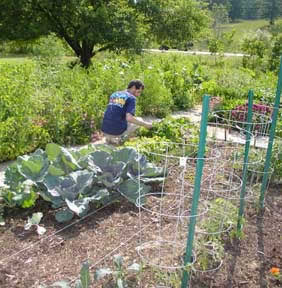|
We admit that "Death By Chocolate" will be our chosen exit strategy if the evening news one day announces that a killer asteroid is about to obliterate the planet. But until then, our chosen approach to keep our food choices healthy: We eat mostly whole (unprocessed) foods, with plenty of it eaten raw (e.g. salads); we emphasize
local food
to maximize freshness; and we eat organic whenever possible.
You too may already be an organic shopper—perhaps you were convinced by Grinning Planet articles on topics like
pesticide residue in food
or
health benefits of organic food.
If you are also a gardener, we're here today to suggest ways you can go organic there too.
Our guest author is Fern Marshall Bradley, co-editor of
The Reader's Digest's All-New Illustrated Guide to Gardening.
She provides some good organic gardening tips for green-thumbs and newbies alike, all designed to save you money on your lawn and garden expenditures.
~ ~ ~
Go Organic to Shrink Your Gardening Budget
by Fern Marshall Bradley
Saving the earth and protecting children and pets from dangerous chemicals are the reasons most gardeners cite for giving up pesticides and synthetic fertilizers, but guess what? Making the switch to organic gardening methods will save you money too! Here are six examples of how going organic will put money back in your pocket.
1. Plant veggies, spend less on doctor bills.
A recent article by a Texas research biochemist summarizes some bad news: many scientific studies show that the vitamin
 content of fresh fruits and vegetables is on the decline. That's alarming, because fresh produce should be an important source of vitamins and minerals in our diets. Without them, we're more vulnerable to getting sick.
content of fresh fruits and vegetables is on the decline. That's alarming, because fresh produce should be an important source of vitamins and minerals in our diets. Without them, we're more vulnerable to getting sick.
Fortunately, there's a simple way to protect your health and reduce what you spend on costly doctor visits, cold and flu medications, and vitamin pills: plant some vegetables. Fresh-picked home garden produce is brimming with nutrition, and recent studies confirm that organically grown produce can be even richer in nutrients than conventionally grown fruits and veggies.
2. Fire your lawn care service.
How much do you pay for a lawn care company to care for your lawn? Chances are it's way too much. So ditch the lawn service and hire a local teen to mow for you instead.
To encourage a healthy lawn the organic way, have your hired help set the mower high—at least 3 inches. That way, your lawn grass naturally shades out weeds. (No more herbicides needed.)
Be sure your helper uses a mulching mower that returns grass clippings—which contain valuable nitrogen—to the lawn. (No more bagged fertilizer needed.) Once a year, have your helper spread good-quality compost too, about 1/4 inch thick. The compost will melt into the lawn almost immediately, adding a wide range of nutrients as well as beneficial microbes that help prevent lawn diseases.
3. Fight pests with flowers instead of pesticides.
More than 90 percent of the insects in your yard and garden are your friends, not your foes. Ladybugs, lacewings, and even many kinds of flies and tiny wasps are an important natural pest control force. Their larvae (the immature stages of the insects) gobble up aphids and other pests, or parasitize the caterpillars that would like to turn the foliage of your flowers and veggies into a holey mess.
One easy way to attract these good-guy insects to your yard organically is to plant a garden of perennials and herbs with tiny flowers, because the adult beneficial insects eat pollen, not bugs. Yarrow, purple coneflowers, daisies, tansy, cosmos, marigolds, and zinnias are great plants to start with, and you'll love how they look growing in sunny spots all around your yard. Buying a few packets of annual seeds and several potted perennials is much cheaper—and much more fun—than buying pesticides and a sprayer!
4. Forget the bagged fertilizer—buy seeds instead.
It's true! A packet of cover-crop seeds such as buckwheat or oats will add as much fertility to your garden beds as any bag of synthetic fertilizer can. And that's just the start of the story. Using synthetic fertilizer is a vicious cycle, because the chemicals in the fertilizer kill or repel beneficial earthworms and other organisms that help build a healthy soil. Plus, chemical fertilizer easily washes down through the soil when it rains, ending up in the groundwater we drink!
|
Not only will you save big in the long term by planting cover crops instead, they also prevent soil erosion, they encourage earthworms and other good guys, and they enrich your soil naturally. Simply sow the cover crop seed on lightly loosened soil, rake it in lightly, and water it to speed germination. Within 4 to 8 weeks, you can cut down the crop with shears or your lawn mower, and all that rich green material will naturally break down, leaving you a nutrient-primed planting bed that will produce bumper crops of veggies, fruit, or flowers.
|
EVEN THREE-LEAF CLOVERS
ARE LUCKY... FOR GARDENERS |
|
At Grinning Planet Farm, we've had great success using the low-growing varieties of clover as a green mulch during the growing season. Once established, the dense clover blocks most other weeds, adds nitrogen to the soil, attracts honeybees and other pollinators, and helps conserve water in the soil. In a comparison of two tomato beds, the bed with clover groundcover required only 1/3 as much watering as the bed with straw mulch.
|
|
5. Reduce your water bill by capturing rainwater.
Depending on where you live, as much as 50 percent of the water you use goes to keeping your garden green and growing. That's a big expense that will only get bigger as water supply problems increase around the country./p>
But for less than $100, you can buy and install a rain barrel that will capture the rain that falls on your roof, providing you a free supply of water for your gardens virtually indefinitely. Rain barrels are available from home centers and mail-order suppliers, and it takes no special skills to install one.
6. Grow gourmet salad toppings on the cheap.
Microgreens are all the rage at fancy restaurants and farm markets, but boy are they expensive!
Here's a secret: you can grow your own microgreens at any time of year on a sunny windowsill for a fraction of the price. Simply save leftover clamshell containers from the deli and buy some organic transplanting mix that's enriched with compost. Clean the containers well, use a barbecue skewer to poke several drainage holes in each one, and fill them with moist potting mix. Then sprinkle veggie seeds—be sure the seeds haven't been treated with pesticides—generously over the soil surface, cover then lightly with more mix, and set the containers in a catch tray on the windowsill. Mist daily until sprouts appear, then water as needed to keep them growing.
Within three weeks, the sprouts will reach the two-leaf stage, and you can snip them with scissors to garnish salads, sandwiches, and entrees. Use lettuce, arugula, and other salad greens, as well as broccoli, kale, dill, cilantro, basil, even peas.
Grinning Planet Wrap-Up
Those weren't just good organic gardening tips, they were great! Thanks, Fern!
Now, back to the Grinning Planet basement, where we're fixing up grow lights for our new organic-cacao plantation room. (Yes, we're kidding—but we are cocoa-nutty here.)
|
Know someone who might like some good organic gardening tips article? Please forward this article to them.
Books:
More articles and resources on....
You can sign up for our free email list so you don't miss anything! Options:
|
|
|


